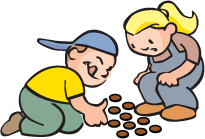Boston Children's Museum
308 Congress Street, Boston, MA 02210
617-426-6500
© Boston Children’s Museum 2025
Website Design by JackrabbitMath is a natural subject to fit into your everyday work with your students. The Mixing in Math curriculum, created by TERC (click here to visit the website), contains lots of great math activities that require little or no materials, and are easy to fit into what you are already doing. This activity, which is adapted from the Mixing in Math curriculum, helps children practice counting forwards and backwards, and practice adding and subtracting. It is also a great logic game for older children.

Ask your students if they ever have to count how many there are of a group of objects. Have they ever had to count a large number of things? Tell them that you are going to teach them a game that requires counting, subtracting and some smarts too.
Play this game and try to take the last penny!
After playing a few times, bring everyone together to discuss. Ask them how they decided how many pennies to take each turn. How can you figure out if you can win on your turn? Is it possible to choose a starting number of pennies that guarantees you will win the game? Does anyone have any other tips or strategies to share?
Send teams back to play again. If they would like, children can play against different players.